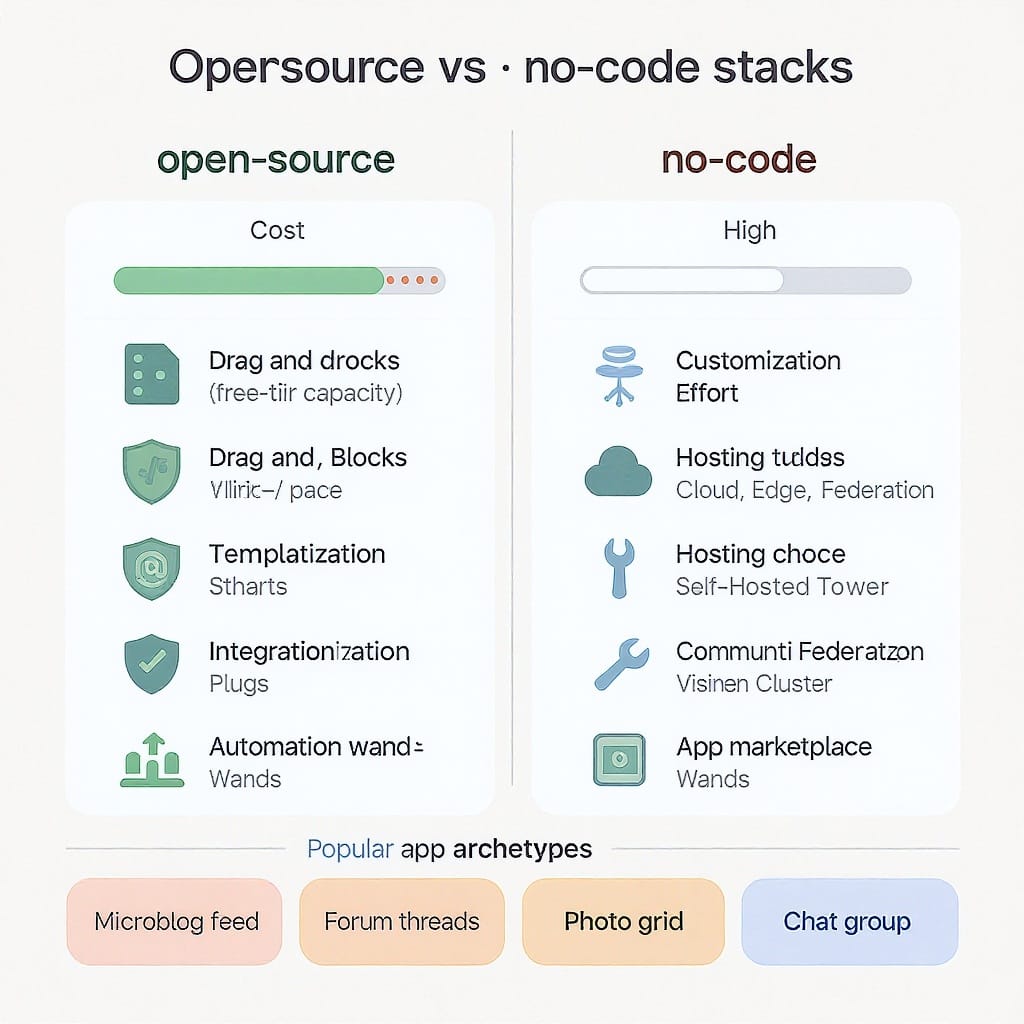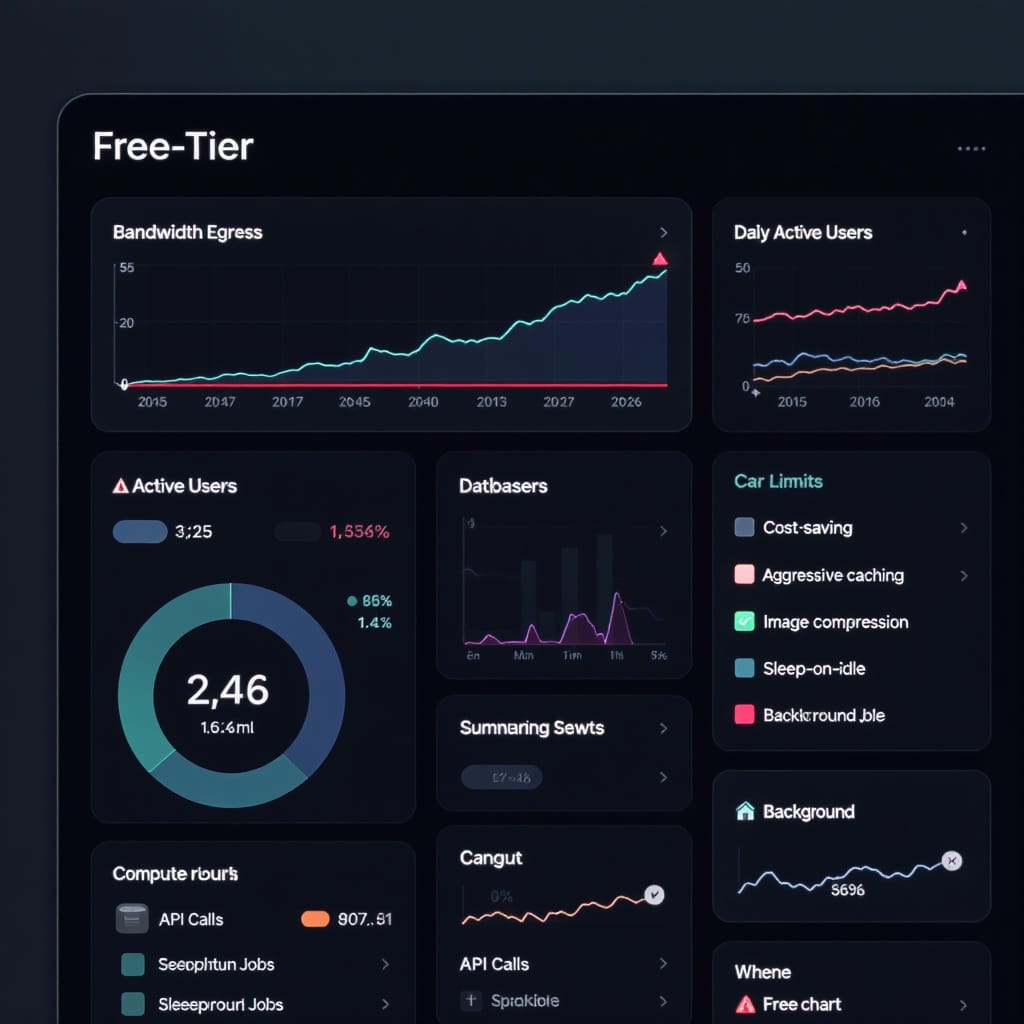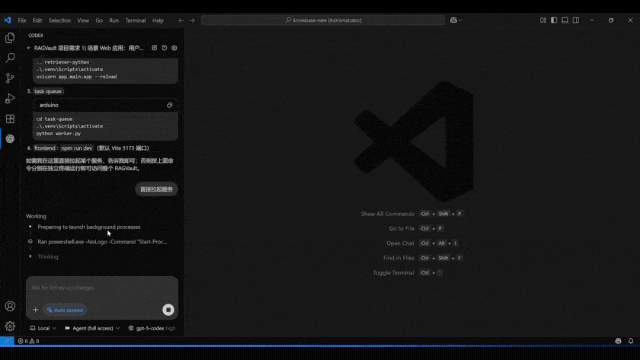How to Create Your Own Social Media for Free: Open‑Source, No‑Code, and Zero‑Cost Hosting Guide
Build your own social platform for free with open-source and no-code tools. Get quick starts, zero-cost hosting tips, and a roadmap for growth and safety.

Launching a community space doesn’t have to cost money or cede control to opaque platforms. This guide focuses on practical, formatting‑friendly steps to set up social tools using open‑source stacks, no‑code options, and free hosting patterns. You’ll get structured quick starts, architecture tips, and a checklist for growth, safety, and maintenance.
How to Create Your Own Social Media for Free: Open‑Source, No‑Code, and Zero‑Cost Hosting Guide


If you’ve ever wished your community had its own space—without ads, opaque algorithms, or data lock‑in—this guide is for you. We’ll walk through practical, battle‑tested ways to free create your own social media for free using open‑source stacks, no‑code tools, and zero‑cost hosting strategies. You’ll get quick starts for microblogging, forums, and a full social site, plus a roadmap for safety, growth, and cost control.
Why build your own social media for free
- Creator communities: Keep fans close, build membership tiers, and own your content pipeline.
- Classrooms and clubs: Safe spaces for classes, sports teams, and maker groups with appropriate moderation.
- Local networks: Neighborhood announcements, mutual aid, and event calendars tailored to your city or campus.
Benefits
- Control and branding: You decide the features, look, and policies.
- Data ownership: Export, migrate, and audit; comply with data requests on your terms.
- Privacy and trust: Transparent moderation and fewer trackers.
Realistic expectations
- Free means time, not money. You’ll trade dollars for DIY setup and light maintenance.
- Reliability improves with upgrades. Start free; move to paid tiers when usage grows.
- “One‑click” is rare. You’ll likely follow a tutorial and paste some scripts.
What “free” really means
Cost areas to watch
- Domain: Optional. You can use a subdomain from a DNS provider or a tunnel URL.
- Hosting: A small Always Free VPS or a spare mini‑PC at home can be enough to start.
- Bandwidth and storage: Media drives cost; use object storage free tiers and CDNs.
- Email: Necessary for signups, password resets, and notifications.
- SSL/TLS: Free via Let’s Encrypt or Cloudflare.
- Maintenance: Updates, backups, and occasional fixes.
How to keep costs at $0
- Use “Always Free” compute tiers or credits from cloud providers.
- Put DNS and SSL behind a free CDN proxy to reduce egress.
- Store media on an S3‑compatible object storage free tier.
- Use a free transactional email plan for limited daily signups.
- Automate backups and pruning to stay inside quotas.
When to plan upgrades
- Consistent daily active users exceed your free CPU/RAM limits.
- Media grows past the free object storage allowance.
- Email deliverability matters (move to a paid, reputable sender).
- You need support SLAs for uptime.
Choose your stack—open‑source vs no‑code
Open‑source platforms give you ActivityPub federation, fine‑grained moderation, and portability. No‑code/low‑code tools ship fast with visual builders but often limit realtime features, background jobs, or webhooks on free plans.
Popular options to consider
- Microblogging (federated): Mastodon, Pleroma/Akkoma
- Forums/communities: Discourse (Rails + Docker), Flarum (PHP)
- Full social networks: HumHub, Elgg
- WordPress + BuddyPress/PeepSo/BuddyBoss: Familiar CMS plus social features
No‑code/low‑code notes
- Good for MVPs, directories, and basic feeds.
- Realtime, streaming, and federation are often limited or paid.
- Vendor lock‑in and API quotas can hit sooner than with OSS.
| Platform | Type | Tech | Min RAM Comfort | Pros | Limits |
|---|---|---|---|---|---|
| Mastodon | Federated microblogging | Ruby, Node, Postgres, Redis | 2–4 GB | Large ecosystem, moderation tools | Heavier stack, email required |
| Akkoma (Pleroma fork) | Federated microblogging | Elixir, Postgres | 1–2 GB | Lightweight, snappy | Smaller community vs Mastodon |
| Discourse | Forum + chat | Ruby, Postgres, Redis, Docker | 2–3 GB | SSO, plugins, trust system | Docker opinionated, RAM hungry |
| Flarum | Forum | PHP, MySQL/MariaDB | 1–2 GB | Lightweight, simple hosting | Less built‑in realtime |
| HumHub | Social network | PHP, MySQL | 2 GB | Spaces, streams, modules | Careful tuning on small VPS |
| WordPress + BuddyPress | Social site + CMS | PHP, MySQL | 1–2 GB | Familiar, many plugins | Requires caching and hardening |
Note: Always verify current resource needs and free tier allowances; they change.
Zero‑cost hosting architecture
Two dependable patterns
- Always Free VPS
- Example: A cloud provider’s “Always Free” VM with 1–2 GB RAM.
- Docker for portability; one container per service.
- Cloudflare DNS proxy and free SSL.
- Object storage (R2 or S3‑compatible) for media.
- Spare mini‑PC + Cloudflare Tunnel
- Run your server at home behind NAT.
- Cloudflare Tunnel exposes HTTPS without port‑forwarding.
- Same Docker + object storage approach.
- Add a cheap UPS for power stability.

Key pieces
- Reverse proxy: Caddy or Nginx, auto‑TLS, HTTP/2/3.
- Database: Postgres or MySQL/MariaDB; enable daily dumps.
- Cache: Redis (sessions, rate limits).
- Media: Object storage bucket for uploads; CDN in front.
- Backups: Push nightly to a second bucket in another provider.
Important
Free allowances and policies change. Check current quotas for compute, egress, object storage ops, and email sending.
Quick start 1 — Microblogging without spend (Mastodon or Akkoma)
Akkoma (Pleroma fork) runs lean and is ideal for tiny servers. Outline below uses Docker on a free VPS. Substitute Mastodon if you have more RAM.
- Provision the server
- Create an Always Free VM (Ubuntu/Debian).
- Add an A/AAAA record in Cloudflare to your domain; enable proxy.
- SSH in and install Docker and Docker Compose plugin:
sudo apt update
sudo apt install -y docker.io docker-compose-plugin
sudo usermod -aG docker $USER- Object storage and email
- Create an S3‑compatible bucket (e.g., Cloudflare R2, a cloud provider’s S3).
- Generate access keys.
- Create a transactional email sender; verify domain and set SPF/DKIM/DMARC. Use a free tier; confirm limits.
- Compose file (Akkoma example)
Create docker-compose.yml:
services:
postgres:
image: postgres:15
environment:
POSTGRES_USER: akkoma
POSTGRES_PASSWORD: strongpassword
POSTGRES_DB: akkoma
volumes:
- db:/var/lib/postgresql/data
restart: unless-stopped
akkoma:
image: ghcr.io/akkoma/akkoma:latest
depends_on:
- postgres
ports:
- "4000:4000"
environment:
DOMAIN: social.example.com
DATABASE_HOST: postgres
DATABASE_USER: akkoma
DATABASE_PASSWORD: strongpassword
DATABASE_DB: akkoma
UPLOADS__BASE_URL: https://cdn.social.example.com
UPLOADS__S3__BUCKET: your-bucket
UPLOADS__S3__REGION: auto
UPLOADS__S3__HOST: your-s3-endpoint
UPLOADS__S3__ACCESS_KEY_ID: yourkey
UPLOADS__S3__SECRET_ACCESS_KEY: yoursecret
MAILER__FROM: no-reply@social.example.com
MAILER__SMTP__HOST: smtp.yourmail.com
MAILER__SMTP__PORT: 587
MAILER__SMTP__USERNAME: apikey
MAILER__SMTP__PASSWORD: yourmailsecret
volumes:
- uploads:/var/lib/akkoma/uploads
- config:/etc/akkoma
restart: unless-stopped
volumes:
db:
uploads:
config:- Reverse proxy and SSL
Use Caddy for auto‑TLS:
sudo apt install -y caddyCaddyfile:
social.example.com {
reverse_proxy localhost:4000
encode zstd gzip
header {
Strict-Transport-Security "max-age=31536000; includeSubDomains; preload"
}
}Reload Caddy:
sudo systemctl reload caddy- Initial admin, moderation, and signups
- Create your account; promote to admin via Akkoma’s admin CLI or web panel.
- Disable open signups or require approval to defeat bot swarms.
- Set rate limits, content filters, and word lists.
- Configure federation settings, relays only if you can moderate them.
- Deliverability and spam
- Enforce email confirmation and hCaptcha/Turnstile on signup pages.
- Monitor email bounces; upgrade sender when volume grows.
Mastodon note: The Docker setup is heavier (web, streaming, sidekiq). Plan for more RAM and swap; keep media on an S3 bucket to avoid filling disk.
Quick start 2 — Community forum hub (Discourse or Flarum)
Discourse is feature‑rich but RAM‑hungry; Flarum is lightweight and PHP‑friendly.
Option A: Discourse (Docker)
- Prereqs
- Ubuntu VM with at least 2 GB RAM (swap helps).
- A domain and email sender.
- Install
sudo -s
apt update && apt install -y docker.io git
git clone https://github.com/discourse/discourse_docker.git /var/discourse
cd /var/discourse
./discourse-setup- Provide domain, email settings, and Let’s Encrypt email.
- The setup script bootstraps and configures a reverse proxy automatically.
- Hardening and free‑tier alignment
- Enable hCaptcha or Turnstile via plugins or site settings.
- Schedule backups to S3/R2. Configure daily backups and 7–14 days retention.
- Turn on rate limits for new users and enable the Akismet or built‑in spam defenses if available in your plan.
- SSO and extensions
- Enable OAuth/SAML or “Sign in with…” providers.
- Add themes and components for polls, galleries, and tags.
Option B: Flarum (PHP)
- Prereqs
- Nginx + PHP‑FPM + MariaDB/MySQL.
- Composer installed.
- Install
composer create-project flarum/flarum . --stability=stable- Configure
- Nginx server block pointing to public/ as document root.
- Set up database, run web installer.
- Add extensions: polls, uploads (S3 backend), SEO, and anti‑spam.
- Backups
- Nightly mysqldump and tar the public/assets.
- Push to object storage with lifecycle rules.
Quick start 3 — WordPress + BuddyPress social site
WordPress is versatile with mature plugins, ideal when you need CMS, pages, and a social layer.
- LEMP stack and caching
- Install Nginx, MariaDB/MySQL, PHP 8.1+.
- Enable FastCGI Cache or Redis Object Cache.
- Set reasonable PHP memory/timeouts for a tiny VPS.
- Install WordPress and BuddyPress
- Use the one‑click CLI:
wp core download
wp config create --dbname=wp --dbuser=wp --dbpass=secret --dbhost=localhost
wp db create
wp core install --url=https://social.example.com --title="My Social" --admin_user=admin --admin_password=strong --admin_email=you@example.com
wp plugin install buddypress --activate- Media and CDN
- Offload uploads to object storage using an S3 plugin.
- Serve images via a CDN or Cloudflare proxy; turn on compression and HTTP/3.
- Anti‑spam and PWA
- Add Turnstile/hCaptcha on register/login forms.
- Consider a PWA plugin to enable offline caching for feed pages.
- Performance tips
- Limit heavy page builders; use a lightweight theme.
- Preload key routes and defer noncritical scripts.
- Use lazy‑loading for images and avatars.
Must‑have features on day one
- Profiles: Display name, avatar, bio, and visibility controls.
- Follow/membership: Following, groups, or roles to shape the social graph.
- Feeds or threads: Chronological or lightly ranked; avoid dark patterns.
- Search: Users, posts, and tags; consider limited full‑text to save CPU.
- DMs or group chat: Optional; moderate abuse vectors carefully.
- Moderation queue: Approvals, quarantines, and escalation paths.
- Reporting tools: In‑app reporting and triage workflows.
- Rate limits: Login, signup, posting, and media uploads.
- Media compression: Resize and transcode images/video; enforce size caps.
- SEO basics: Sitemap, robots.txt, Open Graph/Twitter cards, canonical URLs.
- Accessibility: Alt text prompts, keyboard focus, contrast, ARIA labels.
Safety, policies, and compliance
- Community guidelines: Clear rules and examples; publish strike policy.
- Age gating: If minors could join, consider COPPA and parental consent flows.
- GDPR/CCPA: Data export and deletion; privacy policy and DPA if needed.
- DMCA/Copyright: Takedown email, repeat‑infringer policy, and logging.
- Filters: Blocklists for keywords, domains, and hash‑matched known abuse images.
- Audit trails: Moderator actions, login history, IP logs with retention windows.
- Backups and restore drills: Test recovery quarterly. A backup untested is a liability.
Grow and scale on $0
- Invitations and referrals: Create invite‑only onboarding to reduce spam and improve retention.
- Cross‑posting bridges: Connect to other networks (ActivityPub relays, optional bridges) thoughtfully; moderate federated timelines.
- Free newsletter: Use a free tier for announcements and digests.
- Privacy‑friendly analytics: Self‑host Umami or Matomo; keep data lightweight.
- Caching and image optimization: Edge cache feed pages; use responsive images and WebP/AVIF when supported.
- Upgrade signals: Rising queue times, swap thrashing, and email rate limiting indicate it’s time for more CPU/RAM and a paid sender or CDN.
| Component | Free Strategy | Upgrade Trigger |
|---|---|---|
| Compute | Always Free VM or home mini‑PC + tunnel | High CPU steal, OOM kills, slow page times |
| Media | S3‑compatible free tier + CDN proxy | Bucket near quota, rising egress/ops |
| Transactional free plan | Bounce/delivery issues, daily cap hit | |
| DB | Single small instance, daily dumps | IO wait spikes, slow queries, large indexes |
| Security | Basic WAF, bot protection, rate limits | Targeted abuse or scraping pressure |
Cloudflare Tunnel alternative (no public IP at home)
If you’re running on a home mini‑PC, a tunnel avoids router and ISP hurdles.
- Install cloudflared
curl -L https://github.com/cloudflare/cloudflared/releases/latest/download/cloudflared-linux-amd64.deb -o cloudflared.deb
sudo dpkg -i cloudflared.deb- Authenticate and create a tunnel
cloudflared tunnel login
cloudflared tunnel create my-social
cloudflared tunnel route dns my-social social.example.com- Configure the tunnel (config.yml)
tunnel: my-social
credentials-file: /home/you/.cloudflared/my-social.json
ingress:
- hostname: social.example.com
service: http://localhost:4000
- service: http_status:404- Run as a service
sudo cloudflared --config /etc/cloudflared/config.yml service install
sudo systemctl enable --now cloudflaredMaintenance checklist
- Weekly: Apply security updates, review logs, prune uploads/thumbnails.
- Daily: Verify backups succeeded; spot‑check restore on staging monthly.
- Quarterly: Rotate keys and secrets; review policies and ban lists.
- Ongoing: Keep platform versions updated; read release notes for breaking changes.
Final notes
- Start small. A modest microblog or forum on a free VPS teaches you the ropes.
- Document your setup. Version your Docker files, configs, and IaC snippets.
- Expect to iterate. Your community’s needs will shape features and policies.
If you’ve read this far, you’re ready to free create your own social media for free. Begin with the stack that best matches your community’s vibe, keep costs at zero with careful architecture, and upgrade only when your growth truly demands it.
Summary
This guide organizes free‑tier social platform building into clear sections: choosing a stack, deploying on zero‑cost infrastructure, and hardening for safety and growth. Use lean stacks like Akkoma or Flarum on an Always Free VM or a home mini‑PC with a tunnel, offload media and backups to object storage, and keep email deliverability in mind. Start controlled and invite‑based, automate backups, and watch resource signals to know when to graduate to paid tiers.



